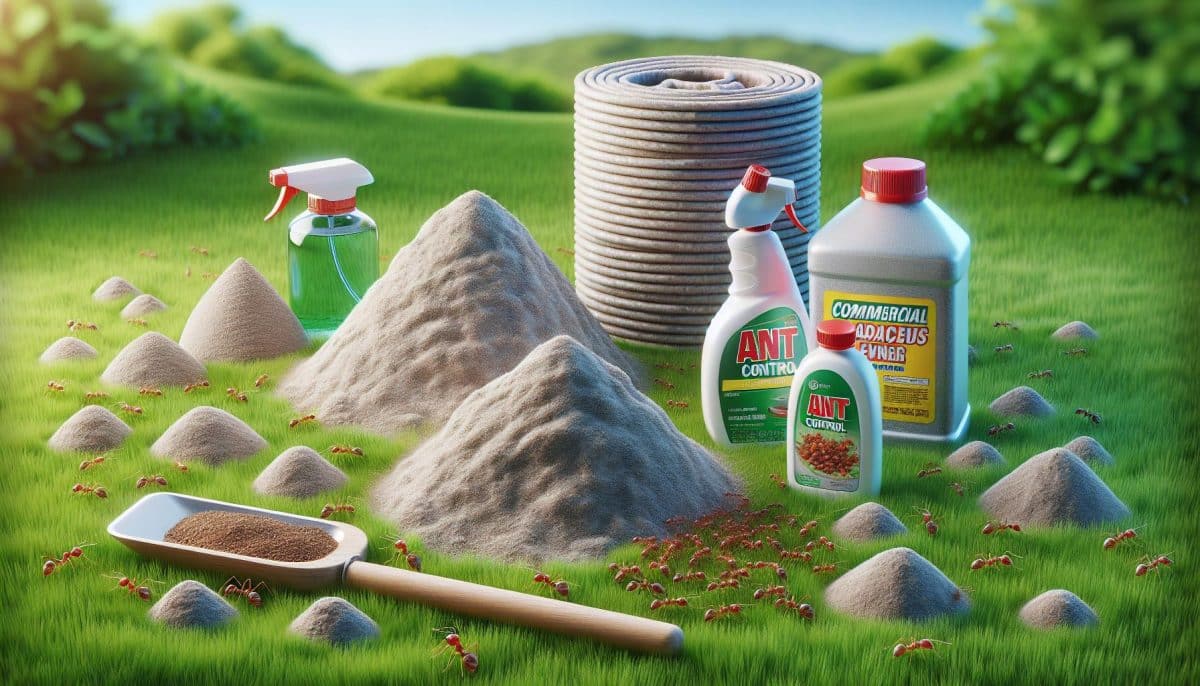
Discovering ants in your lawn can be a real headache, especially when you’ve put in the effort to keep your grass looking its best. Ant colonies not only disrupt the aesthetic appeal of your garden but can also cause harm to your lawn’s health. But don’t worry, you’re not alone in this battle.
Thankfully, there are effective ways to tackle this issue without damaging your precious grass. Whether these uninvited guests have taken over your front garden or nestled next to your flowerpots, knowing how to get rid of ants in your lawn is crucial. Stick around, as we jump into safe and efficient methods to reclaim your green space from these tiny invaders.
Understanding Ants in the Lawn
When you encounter ants in your lawn, it’s essential to understand the intricacies of their world. Ants are not merely nuisances; they play significant roles in the ecosystem. But, their presence can sometimes be overwhelming and detrimental to your lawn’s health. This section delves into identifying various ant species and their behaviors, providing you with the knowledge needed to tackle them effectively.
Identifying Ant Species
The first step in addressing an ant issue in your lawn is identifying the species you’re dealing with. This is crucial because different ants have unique behaviors and preferences, which can affect the treatment approach.
- Field Ants: Characterized by their large mounds, field ants can be unsightly. They create mounds up to 4 feet wide and 2 feet tall, presenting potential trip hazards.
- Carpenter Ants: These are large, black ants, often over one-half inch in length. They’re known for damaging wooden structures but can also be found in lawns.
- Honeydew Producers: Some ant species farm aphids and mealybugs to harvest honeydew. This behavior can lead to an infestation of these pests on your plants.
Understanding the species present in your lawn is the first step towards devising an effective management plan.
Behaviour of Ants in Lawns
Ants in the lawn are not purely destructive. They’re involved in various ecological processes that can be beneficial, such as aerating the soil and recycling nutrients. But, their behaviors can sometimes cause issues.
- Soil Aeration: Ants create tunnels underground, which can help aerate the soil. This process is beneficial for plant roots, allowing better penetration of water and nutrients.
- Pest Control: A healthy colony of ants can reduce the population of turf pests by preying on their larvae. They are natural controllers of pests like aphids and mealybugs.
- Honeydew Farming: The relationship between ants and honeydew-producing pests can be detrimental to your plants. Ants protect these pests from natural predators, encouraging their population growth.
Armed with this understanding of ant identification and behavior, you’re better equipped to make informed decisions on managing these industrious insects in your lawn. From recognizing the beneficial roles ants play to knowing when and how to intervene, every action can make a difference in maintaining the health and aesthetics of your green space.
Prevention Methods

Maintaining a lawn free of ants isn’t just about addressing current infestations; it’s equally about implementing effective prevention tactics. By integrating certain practices into your routine lawn care, you can minimise the chances of ants deciding your lawn is an ideal home. Let’s explore some proven prevention methods.
Keep the Lawn Neat and Clean
One of the most effective ways to deter ants from your lawn is to ensure it remains neat and clean. Ants are attracted to areas that offer shelter and nesting opportunities. Overgrown grass, piles of leaves, or stacks of wood can provide perfect conditions for ants to establish their colonies.
- Mow Regularly: Keeping your lawn trimmed prevents tall grasses, which can attract ants and other pests.
- Remove Debris: Clear away leaves, twigs, and other organic matter regularly. Decomposing plant material can attract ants looking for food and nesting sites.
- Prune Shrubs and Trees: Prevent branches from touching your house or other structures. Ant pathways often stem from these natural bridges.
By sustaining a tidy lawn, you’re removing the essential elements ants need to thrive: shelter and concealment.
Seal Entry Points
Ants are capable of entering your home through the tiniest crevices and cracks. Sealing these entry points not only helps in controlling indoor ant problems but also plays a crucial role in the broader spectrum of lawn ant prevention.
- Inspect Foundations: Look for cracks in the foundation walls and around window frames. Seal any openings with silicone caulk.
- Fix Screens: Ensure window and door screens are intact. Repair any holes to keep ants and other insects outside.
- Secure Vents: Check attic and dryer vents. Use fine mesh to cover openings, providing ventilation while deterring ants.
This method focuses on making your home and, by extension, your lawn less accessible to ants, creating a barrier that dissuades them from setting up their colonies nearby.
Remove Food Sources
Ants venture into your lawn and possibly your home in search of food. By eliminating their food sources, you drastically reduce the lawn’s attractiveness to these persistent invaders.
- Clean up Spills Immediately: Whether it’s on your patio or deck, any food spills should be cleaned promptly to avoid attracting ants.
- Manage Pet Food: Don’t leave pet food outside for long periods. Store food in airtight containers and keep feeding areas clean.
- Trim Fruit Trees: If you have fruit trees, regularly collect fallen fruit. Decaying fruit is a feast for ants and can lead them closer to your home.
A rigorous approach to removing food sources can significantly lessen ant activity in your lawn, making it a less appealing environment for them to invade.
By adopting these preventative measures, you’re not just reacting to ant infestations but proactively creating a lawn environment that’s inherently less inviting to ants. It’s all about consistent lawn care, vigilance, and adopting practices that consider the broader ecology of your garden. Regular implementation of these strategies will contribute significantly to maintaining an ant-free lawn, ensuring your outdoor spaces remain enjoyable and pest-free.
Natural Remedies for Ant Control

Tackling ant infestations in your lawn doesn’t always require harsh chemicals or professional pest control services. There are several natural remedies you can use that are safe for both your family and the environment. Let’s explore how diatomaceous earth, vinegar solutions, and cayenne pepper can become your best allies in the fight against ants.
Diatomaceous Earth
Diatomaceous earth (DE) stands out as a highly effective, natural solution for ant control. It’s a fine powder made from fossilised algae known as diatoms. This substance works by penetrating the exoskeletons of ants, leading to dehydration and death. For the best results, follow these straightforward steps:
- Ensure you’re using food-grade diatomaceous earth, which is safe for pets and humans.
- Sprinkle a thin layer of DE around the ant trails, entry points, or directly on the anthills.
- Reapply after rainfall or watering your lawn, as water diminishes its effectiveness.
One of the key advantages of diatomaceous earth is its safety profile. Unlike chemical pesticides, it’s non-toxic and won’t harm beneficial insects unless directly applied to them. Remember, patience is crucial; it might take a couple of days to see a significant decrease in the ant population.
Vinegar Solution
Vinegar, especially white vinegar, is another powerful tool in your natural ant control arsenal. Ants detest the strong smell of vinegar, and its acidity disrupts their scent trails, effectively disorientating them. To create a vinegar solution for ant control, simply:
- Mix equal parts of water and white vinegar in a spray bottle.
- Add a few drops of eucalyptus or peppermint oil to enhance the repellent effect.
- Spray directly on ant trails, around anthills, and the perimeter of your lawn.
While highly effective for repelling ants and erasing their trails, this solution may need frequent application to maintain its effectiveness. It’s also safe for your lawn in diluted form but practice caution and avoid oversaturating any single area.
Cayenne Pepper
For a spicy take on ant control, cayenne pepper is a surprisingly powerful deterrent. Ants have a strong aversion to the intense spiciness of cayenne, making it an excellent natural repellent. Here’s how to use it:
- Sprinkle cayenne pepper powder directly on anthills or along ant trails.
- For a more potent solution, mix cayenne pepper with water and spray onto affected areas.
This method not only disrupts the ants’ activities but also discourages them from returning. But, it’s worth noting that while cayenne pepper is a potent ant repellent, it should be used sparingly and carefully.
By incorporating these natural remedies into your lawn care routine, you’re not just addressing an ant problem; you’re adopting a more eco-friendly approach to gardening and pest control. Each method has its strengths, and combining them could yield the best results. Remember, consistency and patience are crucial when dealing with natural ant control solutions.
Chemical Treatments

When natural remedies don’t seem to do the trick, and you’re still seeing a line of ants marching across your lawn, it’s time to consider chemical treatments. These potent solutions should be handled with care, but when used correctly, they can offer quick and effective relief from an ant infestation.
Ant Bait Stations
Ant bait stations are a strategic approach to targeting the entire colony, including the elusive queen hiding beneath your lawn. Unlike surface sprays, which kill only the ants you see, bait stations work on the principle of delayed extermination. Here’s how they turn your ant problem into a solution:
- The Setup: These stations contain a mix of attractants and slow-acting insecticides. You’ll place them around your lawn, focusing on areas with high ant activity.
- The Process: Foraging ants, lured by the bait, carry it back to their nest. The key here is patience. It might take a few days, but eventually, the toxic bait spreads throughout the colony.
- The Outcome: Ideally, the entire colony, including the queen, consumes the bait, leading to the nest’s collapse.
Remember, success with ant bait stations requires correct placement and possibly multiple applications, especially for larger colonies. Always follow the manufacturer’s instructions for the safest and most effective use.
Ant Spray
For immediate action against visible ants and surface nests, an ant spray is your go-to solution. Here are some critical points to keep in mind when using ant sprays:
- Direct Action: Ant sprays are contact insecticides, meaning they kill ants on contact. They’re ideal for treating visible trails and the outer areas of nests.
- Chemical Composition: Many sprays contain pyrethroids, chemicals that affect the nervous system of ants, providing a quick knockdown effect.
- Application Tips: Spray directly onto ants and their trails. For nests, aim to spray around the entrance. It’s essential not to disturb the nest beforehand to ensure ants don’t scatter.
While effective, remember sprays provide a temporary solution. They kill the ants you see but won’t eliminate the problem at its source—the nest. For a comprehensive approach, consider combining sprays with bait stations.
Utilizing these chemical treatments requires a responsible approach. Always prioritize safety for both yourself and the environment. Gloves, masks, and following product guides are non-negotiable steps to ensure that your battle against ants leads to a victorious, yet safe, garden and lawn for everyone to enjoy.
Conclusion
Tackling ant infestations in your lawn doesn’t have to be a challenging job. By choosing the right approach, whether it’s natural remedies like diatomaceous earth, vinegar, and cayenne pepper, or opting for chemical treatments such as ant bait stations and sprays, you’re well on your way to reclaiming your green space. Remember, the key is to target not just the visible ants but the entire colony to ensure a long-lasting solution. Always prioritise safety and environmental considerations, especially when using chemical methods. With patience and the right strategy, you’ll enjoy an ant-free lawn that’s perfect for those sunny days outdoors.
Colin Macmillan is a seasoned entrepreneur and the CEO of Riverwood Landscape, a leading landscaping company based in Canada. He has been at the helm of the company since leaving high school, demonstrating his strong leadership skills and business acumen.
Colin’s expertise lies in various aspects of landscaping, including lawn care, interlocking, sod installation, and commercial maintenance. His hands-on approach and dedication to the craft have been instrumental in building Riverwood Landscape into a reputable brand.
One of his most notable achievements is the creation of a successful landscape franchise that services multiple locations. This accomplishment underscores his strategic thinking and ability to scale operations effectively.
Colin has also had the privilege of working with Guelph Hospital for landscaping and maintenance, a testament to the trust and reliability that his company has earned over the years.
His professional mission is to offer the best services and experiences for customers, a goal that he tirelessly pursues. Colin’s commitment to excellence and customer satisfaction continues to drive the growth and success of Riverwood Landscape.








